2005 PONTIAC BONNEVILLE service interval
[x] Cancel search: service intervalPage 345 of 438
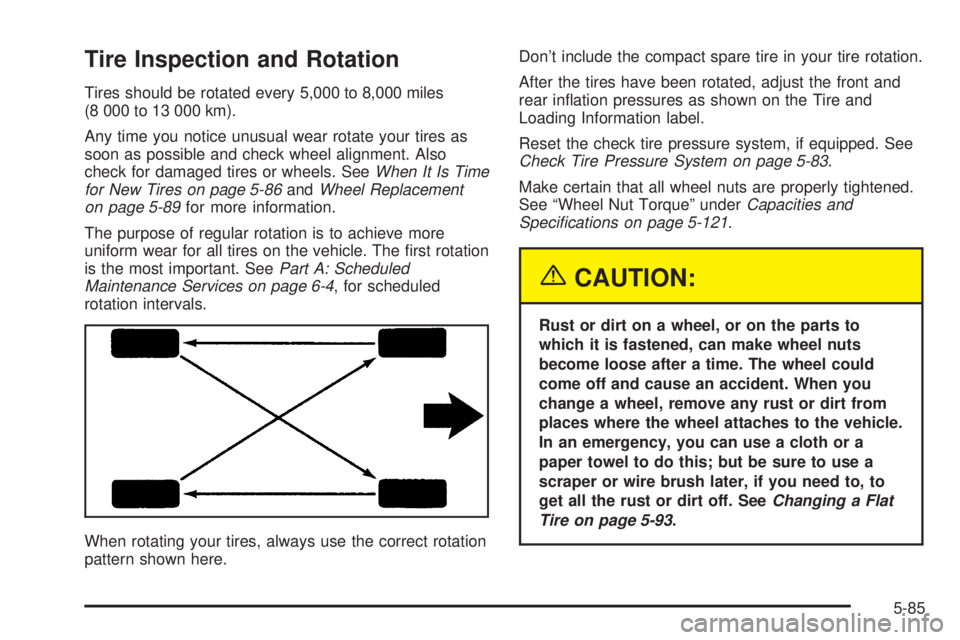
Tire Inspection and Rotation
Tires should be rotated every 5,000 to 8,000 miles
(8 000 to 13 000 km).
Any time you notice unusual wear rotate your tires as
soon as possible and check wheel alignment. Also
check for damaged tires or wheels. SeeWhen It Is Time
for New Tires on page 5-86andWheel Replacement
on page 5-89for more information.
The purpose of regular rotation is to achieve more
uniform wear for all tires on the vehicle. The �rst rotation
is the most important. SeePart A: Scheduled
Maintenance Services on page 6-4, for scheduled
rotation intervals.
When rotating your tires, always use the correct rotation
pattern shown here.Don’t include the compact spare tire in your tire rotation.
After the tires have been rotated, adjust the front and
rear in�ation pressures as shown on the Tire and
Loading Information label.
Reset the check tire pressure system, if equipped. See
Check Tire Pressure System on page 5-83.
Make certain that all wheel nuts are properly tightened.
See “Wheel Nut Torque” underCapacities and
Speci�cations on page 5-121.
{CAUTION:
Rust or dirt on a wheel, or on the parts to
which it is fastened, can make wheel nuts
become loose after a time. The wheel could
come off and cause an accident. When you
change a wheel, remove any rust or dirt from
places where the wheel attaches to the vehicle.
In an emergency, you can use a cloth or a
paper towel to do this; but be sure to use a
scraper or wire brush later, if you need to, to
get all the rust or dirt off. SeeChanging a Flat
Tire on page 5-93.
5-85
Page 386 of 438
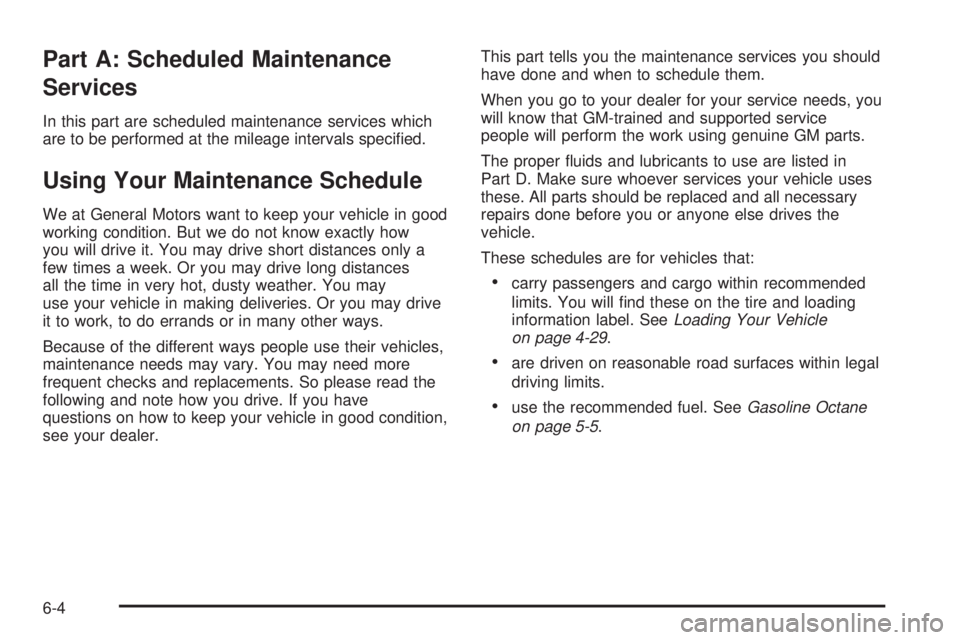
Part A: Scheduled Maintenance
Services
In this part are scheduled maintenance services which
are to be performed at the mileage intervals speci�ed.
Using Your Maintenance Schedule
We at General Motors want to keep your vehicle in good
working condition. But we do not know exactly how
you will drive it. You may drive short distances only a
few times a week. Or you may drive long distances
all the time in very hot, dusty weather. You may
use your vehicle in making deliveries. Or you may drive
it to work, to do errands or in many other ways.
Because of the different ways people use their vehicles,
maintenance needs may vary. You may need more
frequent checks and replacements. So please read the
following and note how you drive. If you have
questions on how to keep your vehicle in good condition,
see your dealer.This part tells you the maintenance services you should
have done and when to schedule them.
When you go to your dealer for your service needs, you
will know that GM-trained and supported service
people will perform the work using genuine GM parts.
The proper �uids and lubricants to use are listed in
Part D. Make sure whoever services your vehicle uses
these. All parts should be replaced and all necessary
repairs done before you or anyone else drives the
vehicle.
These schedules are for vehicles that:
carry passengers and cargo within recommended
limits. You will �nd these on the tire and loading
information label. SeeLoading Your Vehicle
on page 4-29.
are driven on reasonable road surfaces within legal
driving limits.
use the recommended fuel. SeeGasoline Octane
on page 5-5.
6-4
Page 387 of 438
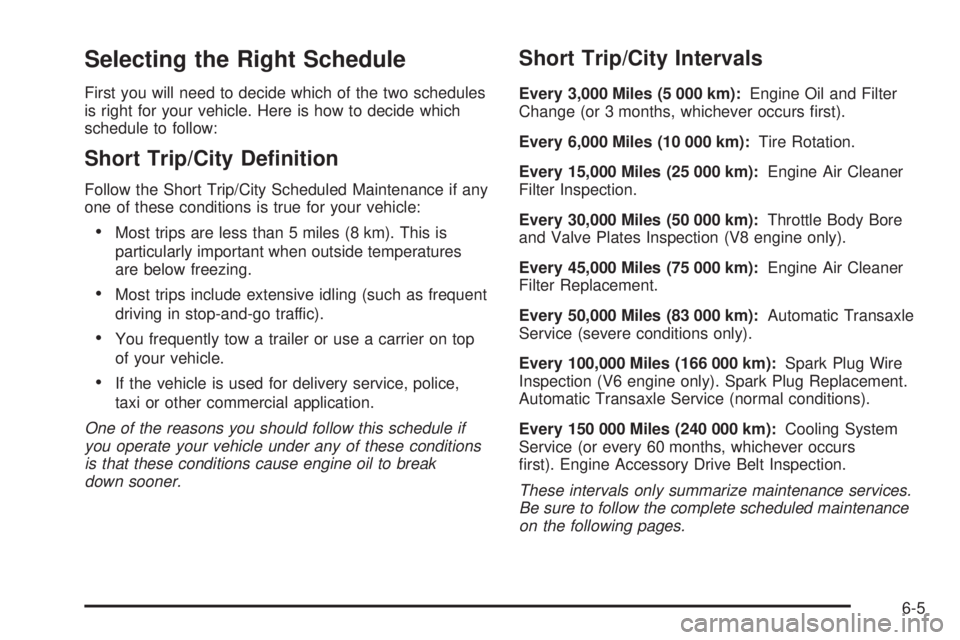
Selecting the Right Schedule
First you will need to decide which of the two schedules
is right for your vehicle. Here is how to decide which
schedule to follow:
Short Trip/City De�nition
Follow the Short Trip/City Scheduled Maintenance if any
one of these conditions is true for your vehicle:
Most trips are less than 5 miles (8 km). This is
particularly important when outside temperatures
are below freezing.
Most trips include extensive idling (such as frequent
driving in stop-and-go traffic).
You frequently tow a trailer or use a carrier on top
of your vehicle.
If the vehicle is used for delivery service, police,
taxi or other commercial application.
One of the reasons you should follow this schedule if
you operate your vehicle under any of these conditions
is that these conditions cause engine oil to break
down sooner.
Short Trip/City Intervals
Every 3,000 Miles (5 000 km):Engine Oil and Filter
Change (or 3 months, whichever occurs �rst).
Every 6,000 Miles (10 000 km):Tire Rotation.
Every 15,000 Miles (25 000 km):Engine Air Cleaner
Filter Inspection.
Every 30,000 Miles (50 000 km):Throttle Body Bore
and Valve Plates Inspection (V8 engine only).
Every 45,000 Miles (75 000 km):Engine Air Cleaner
Filter Replacement.
Every 50,000 Miles (83 000 km):Automatic Transaxle
Service (severe conditions only).
Every 100,000 Miles (166 000 km):Spark Plug Wire
Inspection (V6 engine only). Spark Plug Replacement.
Automatic Transaxle Service (normal conditions).
Every 150 000 Miles (240 000 km):Cooling System
Service (or every 60 months, whichever occurs
�rst). Engine Accessory Drive Belt Inspection.
These intervals only summarize maintenance services.
Be sure to follow the complete scheduled maintenance
on the following pages.
6-5
Page 388 of 438
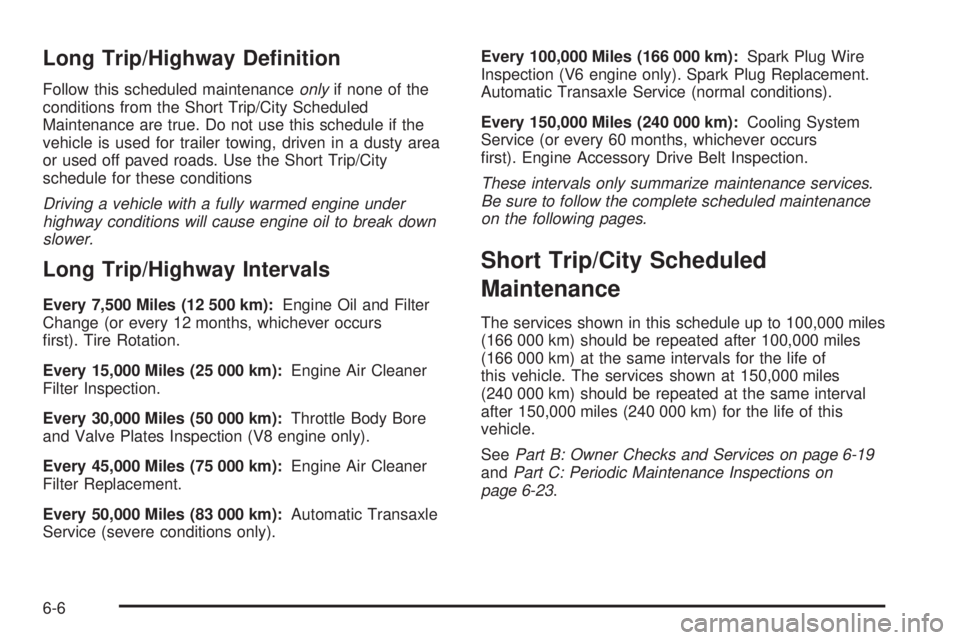
Long Trip/Highway De�nition
Follow this scheduled maintenanceonlyif none of the
conditions from the Short Trip/City Scheduled
Maintenance are true. Do not use this schedule if the
vehicle is used for trailer towing, driven in a dusty area
or used off paved roads. Use the Short Trip/City
schedule for these conditions
Driving a vehicle with a fully warmed engine under
highway conditions will cause engine oil to break down
slower.
Long Trip/Highway Intervals
Every 7,500 Miles (12 500 km):Engine Oil and Filter
Change (or every 12 months, whichever occurs
�rst). Tire Rotation.
Every 15,000 Miles (25 000 km):Engine Air Cleaner
Filter Inspection.
Every 30,000 Miles (50 000 km):Throttle Body Bore
and Valve Plates Inspection (V8 engine only).
Every 45,000 Miles (75 000 km):Engine Air Cleaner
Filter Replacement.
Every 50,000 Miles (83 000 km):Automatic Transaxle
Service (severe conditions only).Every 100,000 Miles (166 000 km):Spark Plug Wire
Inspection (V6 engine only). Spark Plug Replacement.
Automatic Transaxle Service (normal conditions).
Every 150,000 Miles (240 000 km):Cooling System
Service (or every 60 months, whichever occurs
�rst). Engine Accessory Drive Belt Inspection.
These intervals only summarize maintenance services.
Be sure to follow the complete scheduled maintenance
on the following pages.
Short Trip/City Scheduled
Maintenance
The services shown in this schedule up to 100,000 miles
(166 000 km) should be repeated after 100,000 miles
(166 000 km) at the same intervals for the life of
this vehicle. The services shown at 150,000 miles
(240 000 km) should be repeated at the same interval
after 150,000 miles (240 000 km) for the life of this
vehicle.
SeePart B: Owner Checks and Services on page 6-19
andPart C: Periodic Maintenance Inspections on
page 6-23.
6-6
Page 389 of 438
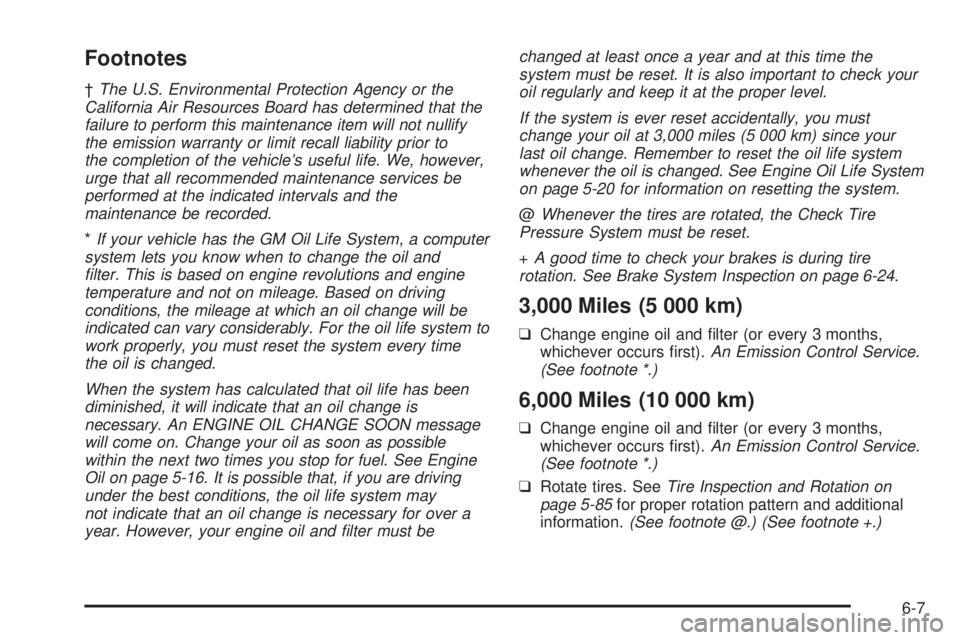
Footnotes
†The U.S. Environmental Protection Agency or the
California Air Resources Board has determined that the
failure to perform this maintenance item will not nullify
the emission warranty or limit recall liability prior to
the completion of the vehicle’s useful life. We, however,
urge that all recommended maintenance services be
performed at the indicated intervals and the
maintenance be recorded.
*If your vehicle has the GM Oil Life System, a computer
system lets you know when to change the oil and
�lter. This is based on engine revolutions and engine
temperature and not on mileage. Based on driving
conditions, the mileage at which an oil change will be
indicated can vary considerably. For the oil life system to
work properly, you must reset the system every time
the oil is changed.
When the system has calculated that oil life has been
diminished, it will indicate that an oil change is
necessary. An ENGINE OIL CHANGE SOON message
will come on. Change your oil as soon as possible
within the next two times you stop for fuel. See Engine
Oil on page 5-16.It is possible that, if you are driving
under the best conditions, the oil life system may
not indicate that an oil change is necessary for over a
year. However, your engine oil and �lter must bechanged at least once a year and at this time the
system must be reset. It is also important to check your
oil regularly and keep it at the proper level.
If the system is ever reset accidentally, you must
change your oil at 3,000 miles (5 000 km) since your
last oil change. Remember to reset the oil life system
whenever the oil is changed. See Engine Oil Life System
on page 5-20 for information on resetting the system.
@Whenever the tires are rotated, the Check Tire
Pressure System must be reset.
+A good time to check your brakes is during tire
rotation. See Brake System Inspection on page 6-24.
3,000 Miles (5 000 km)
❑Change engine oil and �lter (or every 3 months,
whichever occurs �rst).An Emission Control Service.
(See footnote *.)
6,000 Miles (10 000 km)
❑Change engine oil and �lter (or every 3 months,
whichever occurs �rst).An Emission Control Service.
(See footnote *.)
❑Rotate tires. SeeTire Inspection and Rotation on
page 5-85for proper rotation pattern and additional
information.(See footnote @.) (See footnote +.)
6-7
Page 395 of 438

❑Rotate tires. SeeTire Inspection and Rotation on
page 5-85for proper rotation pattern and additional
information.(See footnote @.) (See footnote +.)
99,000 Miles (165 000 km)
❑Change engine oil and �lter (or every 3 months,
whichever occurs �rst).An Emission Control Service.
(See footnote *.)
100,000 Miles (166 000 km)
❑V6 engine only: Inspect spark plug wires.An
Emission Control Service.
❑Replace spark plugs.An Emission Control Service.
❑Change automatic transaxle �uid and �lter if the
vehicle is mainly driven under one or more of
these conditions:
� In heavy city traffic where the outside
temperature regularly reaches 90°F (32°C) or
higher.
� In hilly or mountainous terrain.
� When doing frequent trailer towing.
� Uses such as found in taxi, police or delivery
service.
If you have not used your vehicle under severe service
conditions listed previously and, therefore, have not
changed your automatic transaxle �uid, change both the
�uid and �lter.
150,000 Miles (240 000 km)
❑Drain, �ush and re�ll cooling system (or every
60 months since last service, whichever occurs �rst).
SeeEngine Coolant (3.8L V6 Engine) on page 5-31
orEngine Coolant (4.6L V8 Engine) on page 5-34for
what to use. Inspect hoses. Clean radiator,
condenser, pressure cap and neck. Pressure test the
cooling system and pressure cap.An Emission
Control Service.
❑Inspect engine accessory drive belt.An Emission
Control Service.
Long Trip/Highway Scheduled
Maintenance
The services shown in this schedule up to 100,000 miles
(166 000 km) should be repeated after 100,000 miles
(166 000 km) at the same intervals for the life of
this vehicle. The services shown at 150,000 miles
(240 000 km) should be repeated at the same interval
after 150,000 miles (240 000 km) for the life of this
vehicle.
SeePart B: Owner Checks and Services on page 6-19
andPart C: Periodic Maintenance Inspections on
page 6-23.
6-13
Page 396 of 438
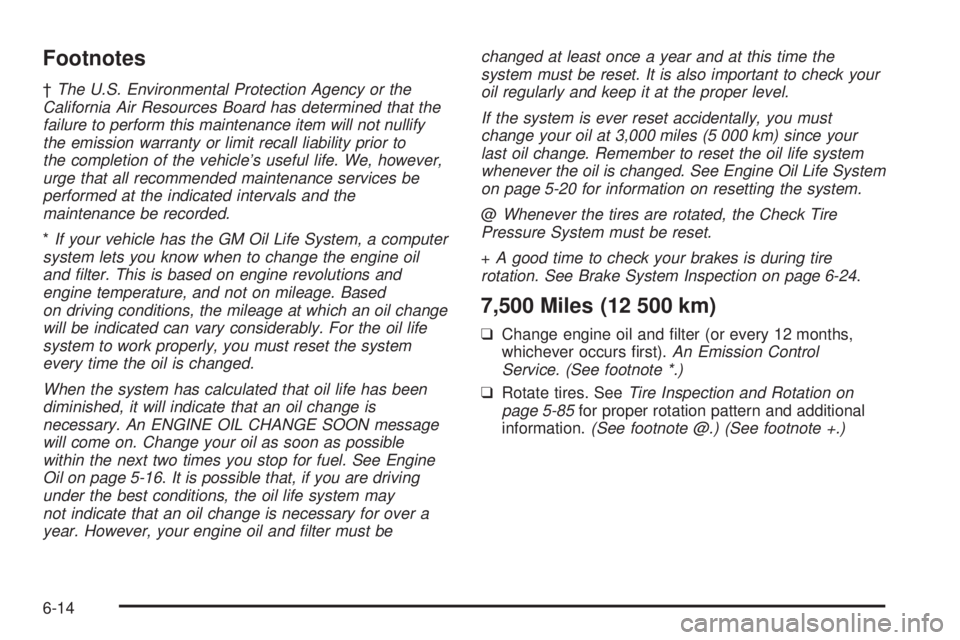
Footnotes
†The U.S. Environmental Protection Agency or the
California Air Resources Board has determined that the
failure to perform this maintenance item will not nullify
the emission warranty or limit recall liability prior to
the completion of the vehicle’s useful life. We, however,
urge that all recommended maintenance services be
performed at the indicated intervals and the
maintenance be recorded.
*If your vehicle has the GM Oil Life System, a computer
system lets you know when to change the engine oil
and �lter. This is based on engine revolutions and
engine temperature, and not on mileage. Based
on driving conditions, the mileage at which an oil change
will be indicated can vary considerably. For the oil life
system to work properly, you must reset the system
every time the oil is changed.
When the system has calculated that oil life has been
diminished, it will indicate that an oil change is
necessary. An ENGINE OIL CHANGE SOON message
will come on. Change your oil as soon as possible
within the next two times you stop for fuel. See Engine
Oil on page 5-16.It is possible that, if you are driving
under the best conditions, the oil life system may
not indicate that an oil change is necessary for over a
year. However, your engine oil and �lter must bechanged at least once a year and at this time the
system must be reset. It is also important to check your
oil regularly and keep it at the proper level.
If the system is ever reset accidentally, you must
change your oil at 3,000 miles (5 000 km) since your
last oil change. Remember to reset the oil life system
whenever the oil is changed. See Engine Oil Life System
on page 5-20 for information on resetting the system.
@Whenever the tires are rotated, the Check Tire
Pressure System must be reset.
+A good time to check your brakes is during tire
rotation. See Brake System Inspection on page 6-24.
7,500 Miles (12 500 km)
❑Change engine oil and �lter (or every 12 months,
whichever occurs �rst).An Emission Control
Service. (See footnote *.)
❑Rotate tires. SeeTire Inspection and Rotation on
page 5-85for proper rotation pattern and additional
information.(See footnote @.) (See footnote +.)
6-14
Page 401 of 438
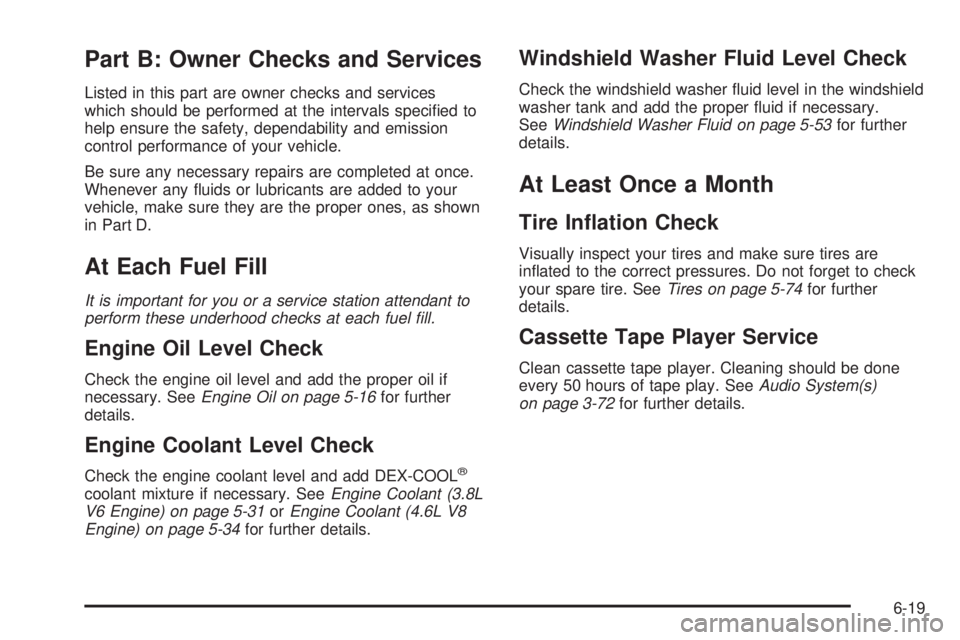
Part B: Owner Checks and Services
Listed in this part are owner checks and services
which should be performed at the intervals speci�ed to
help ensure the safety, dependability and emission
control performance of your vehicle.
Be sure any necessary repairs are completed at once.
Whenever any �uids or lubricants are added to your
vehicle, make sure they are the proper ones, as shown
in Part D.
At Each Fuel Fill
It is important for you or a service station attendant to
perform these underhood checks at each fuel �ll.
Engine Oil Level Check
Check the engine oil level and add the proper oil if
necessary. SeeEngine Oil on page 5-16for further
details.
Engine Coolant Level Check
Check the engine coolant level and add DEX-COOL®
coolant mixture if necessary. SeeEngine Coolant (3.8L
V6 Engine) on page 5-31orEngine Coolant (4.6L V8
Engine) on page 5-34for further details.
Windshield Washer Fluid Level Check
Check the windshield washer �uid level in the windshield
washer tank and add the proper �uid if necessary.
SeeWindshield Washer Fluid on page 5-53for further
details.
At Least Once a Month
Tire In�ation Check
Visually inspect your tires and make sure tires are
in�ated to the correct pressures. Do not forget to check
your spare tire. SeeTires on page 5-74for further
details.
Cassette Tape Player Service
Clean cassette tape player. Cleaning should be done
every 50 hours of tape play. SeeAudio System(s)
on page 3-72for further details.
6-19